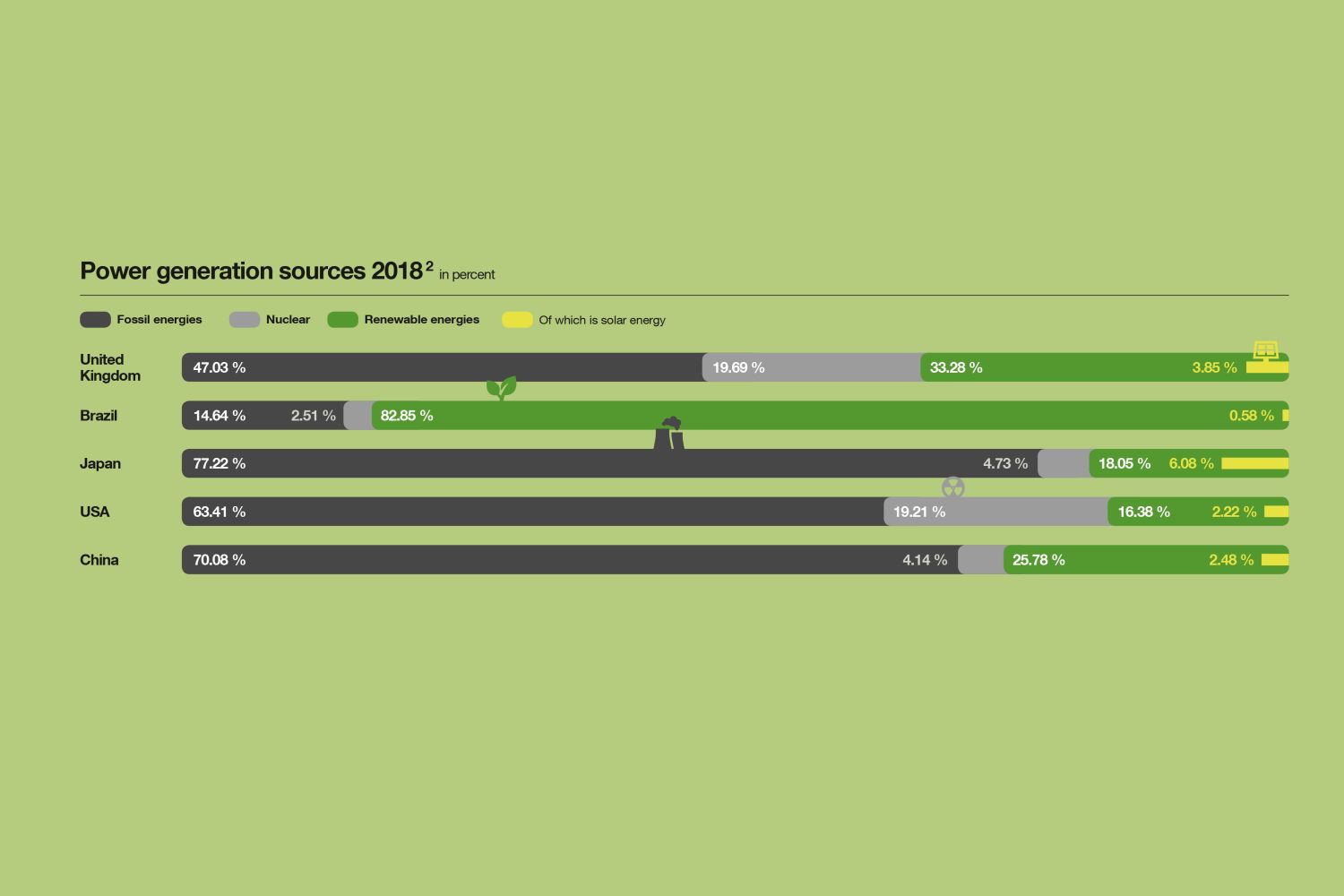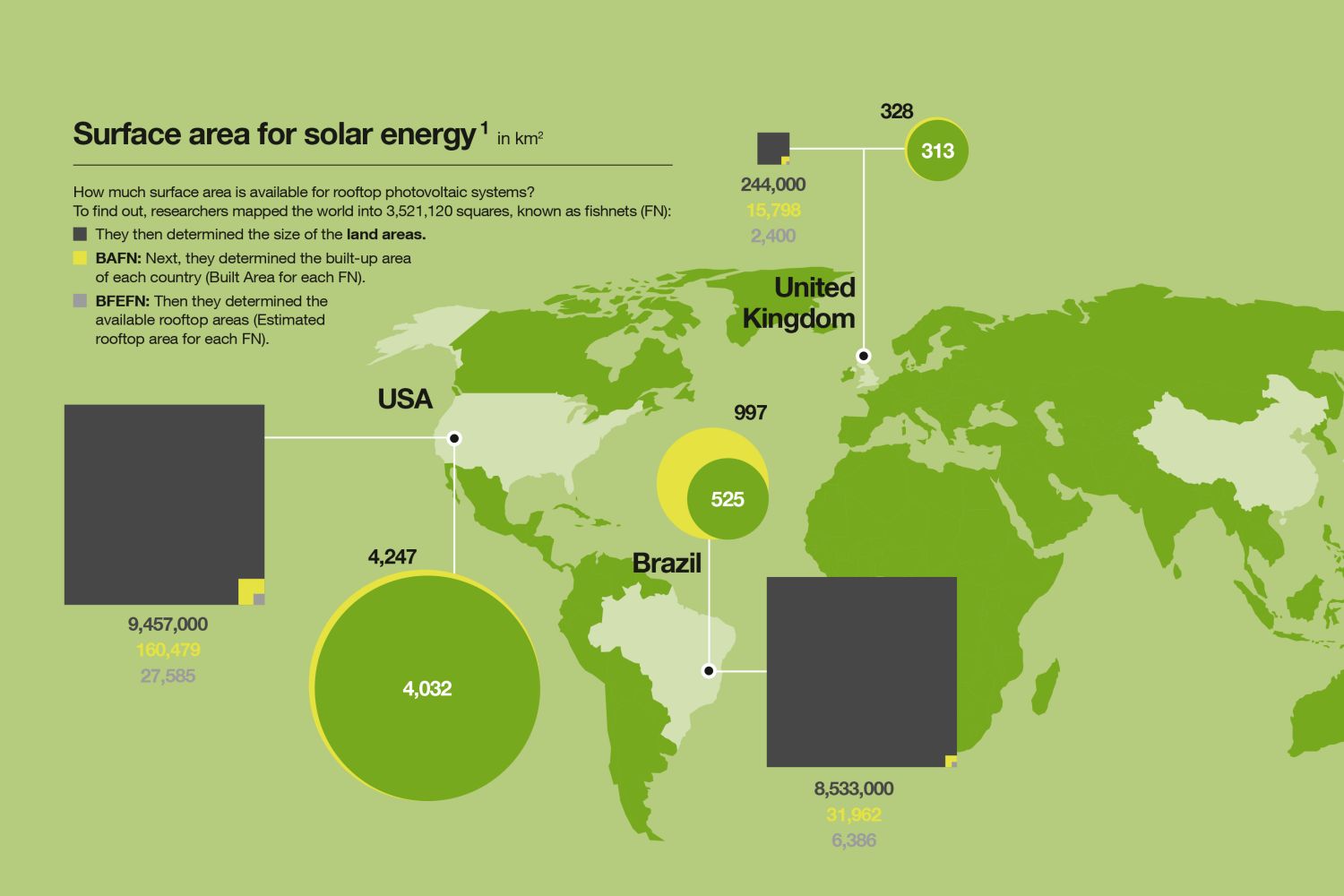This is How We Catch the Sun
Author: Joachim Geiger
Rooftop systems already account for around 40 percent of photovoltaics installed worldwide. But why not dream bigger? Why not step up the pace of rooftop PV expansion to reduce greenhouse gas emissions and put an end to energy poverty? An international study has calculated the true potential of rooftop systems worldwide.
Could sufficient energy be made available to people all over the world if every single building were equipped with photovoltaic rooftop systems? What would the sum of the world’s rooftop areas even be? And how much energy could this generate? Admittedly, these questions sound hypothetical at first, even in these times of climate change and energy crisis.
On the other hand, access to affordable, reliable, and sustainable energy has long been a top priority among the 17 goals that the United Nations wrote into its Global Sustainability Agenda in 2016. In addition, market researchers are currently attesting to a boom in rooftop PV systems – already, 40 percent of photovoltaics installed globally are rooftop systems. So taking a closer look at these questions might be worthwhile. An international team of researchers, led by scientists from University College Cork (UCC) in Ireland and Columbia University in the USA, has now set itself this task.
Published in October 2021, their analysis “High resolution global spatiotemporal assessment of rooftop solar photovoltaics potential for renewable electricity generation” arrives at a clear conclusion: Based on 2018 as reference year, rooftop PV installations worldwide could generate 27 trillion kilowatt hours of electricity on a total of 200,000 square kilometers of rooftop areas. That is more than the world’s electricity demand of that year – which the International Energy Agency (IEA) puts at 24.7 trillion kilowatt hours.
Big data and AI applications are remeasuring the world
This scientific finding is based on a highly complex approach. But how could it contribute to solving the world’s energy problems? Especially since the study’s authors do not advocate installing a solar system on every rooftop in the world. The goal is a different one: First, rooftop PV systems represent a low-carbon, highly available, and inexpensive technology. Second, 800 million people worldwide still live without electricity.
This is where the study comes in, as a useful tool for all governments, organizations, and companies that are committed to building PV infrastructure. Essentially, this work is about nothing less than accurately scanning 130 million square kilometers of land for its solar potential. Obviously, such a mammoth project requires a high level of methodical creativity and tangible support from AI applications.
The researchers’ core issue is satellite image evaluation
The researchers analyzed cadastral data, crowd sourced data, and satellite based data, among other things, to determine building layouts, climate conditions, solar radiation, and technology specific information related to photovoltaics. All in all, this involved petabytes of data, which clearly puts the study in the realm of big data.
One core issue for the researchers was the analysis of the satellite images. There is no program that can precisely distinguish rooftop areas from green or fallow spaces. The key to the solution: If you relate data on population size to the length of roads and the boundaries of built-up areas, you can infer the existing rooftop areas. To do this, the scientists developed a machine learning model that can independently assess unknown data based on comprehensive training data. To do so, they divided the entire global land mass into assessment units of ten square kilometers each – adding up to exactly 3,521,120 squares, all of which had a unique identifier and were assigned to a unique country.
The learning program itself contained a gigantic amount of samples, corresponding to about 11.4 million square kilometers of land area and 300 million individual buildings. This was used as the foundation for calculating the assessment units – with a data set of the respective building area for each individual assessment cell. But that was not the end of it – after all, the rooftop areas still had to be converted into solar potential. The values for climate and solar radiation, as well as the technology costs, also had to be taken into account.


The greatest potential for rooftop PV systems
The spectacular result of this scientific effort is the complete geographical mapping of the technical potential, seasonal changes in solar radiation, and the cost of rooftop photovoltaics.
With this information, it is now possible to determine, for example, which region and countries have the greatest resources for the production of solar energy. At the top of the list are Asia, North America, and Europe. Here, rooftop PV installations in areas characterized by high per capita electricity consumption could help reduce the fossil fuel content of the current energy mix. The researchers also believe that emerging markets such as India, Brazil, and Mexico offer good preconditions for the introduction of rooftop PV systems.
However, due to high upfront costs and a lack of credit lines for financing, the acceptance of this technology has been rather low in these countries so far. It may initially come as a surprise that the African continent places last in the potentials analysis, despite good climatic conditions. However, a closer look reveals that – apart from the regions in the west and north – the building stock on the continent as a whole is still too small to build on and grow significant resources.
Global collaboration and technology transfers
And what about the use of solar energy in the world’s megacities and metropolitan areas? Here, too, the study offers some surprising insight. At around 55 percent, the greatest potential is not located where most people live, but in sparsely populated areas where there is often no or limited grid integration. It therefore stands to reason that rooftop PV systems have a bright future in rural energy systems.
Furthermore, it is logical for the study to provide local governments with precise indications of where in the country to find the best locations for building an infrastructure with rooftop PV systems. The practical implementation of a decentralized solar energy system will be the true proving grounds. Countries with weak gross domestic product (GDP) in particular will then face a dilemma – they simply lack the money to achieve their specific solar energy potential with the necessary investments.
The authors of the study therefore believe that the responsibility falls especially on developed economies: Global collaboration and technology transfers are needed to help disadvantaged countries build a clean power generation infrastructure. The remarkable study offers a good approach.


